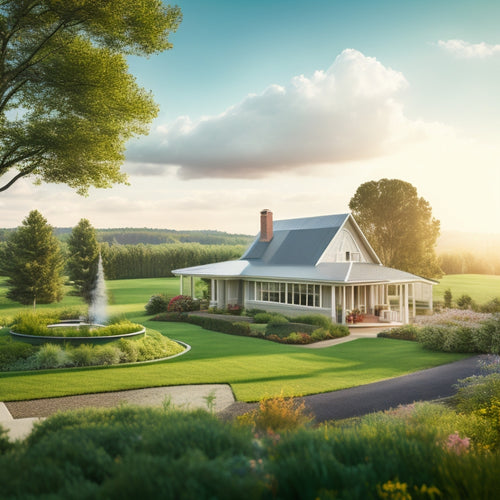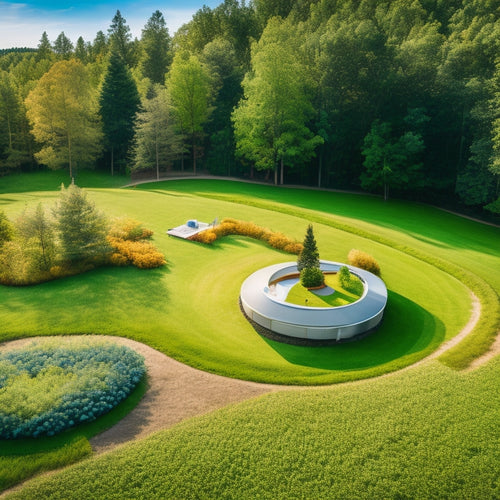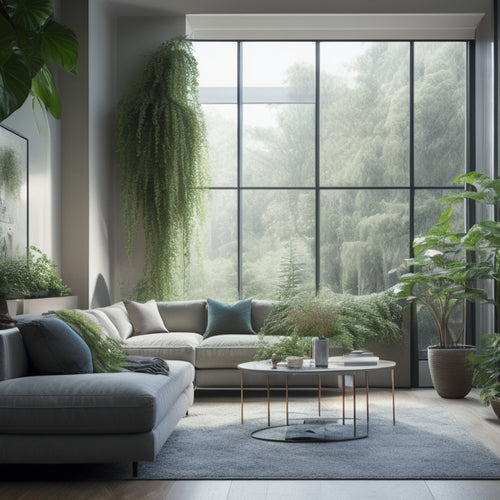
10 Green Building Tricks for Lower Energy Bills
Share
You're about to reveal the secrets to slashing your energy bills by as much as 50%! Start by utilizing natural light sources through strategic window placement and light tubes, which can reduce your reliance on artificial lighting. Then, optimize your building's natural heat and light capture with passive solar design. Make the switch to energy-efficient windows, eco-friendly roofing materials, and sustainable flooring options like reclaimed wood and bamboo. Improve air tightness techniques, choose low-VOC paints, and insulate with recycled materials to further minimize energy consumption. By incorporating these green building tricks, you'll be well on your way to a more sustainable future - and there's even more to investigate.
Key Takeaways
- Harness natural light sources through strategic window placement and daylight harvesting to reduce artificial lighting needs and energy bills.
- Incorporate passive solar design by optimizing solar orientation and implementing shading strategies to maximize natural light and heat capture.
- Install energy-efficient windows with low U-factors and sustainable frame materials to minimize summer heat gain and maximize insulation.
- Insulate with recycled materials to conserve natural resources, reduce embodied energy, and lower energy bills.
- Utilize on-site renewable energy systems like solar panels to generate electricity and reduce reliance on the grid.
Harness Natural Light Sources
By day, natural light pours in through windows, reducing the need for artificial lighting and saving you money on energy bills.
You can maximize this benefit by incorporating daylight harvesting into your green building design. This involves strategically placing windows, skylights, and light tubes to funnel natural light into your space.
When designing your solar charging infrastructure, it's crucial to conduct energy audits to optimize energy consumption patterns and identify peak demand.
Light tubes, for instance, are reflective tubes that channel sunlight from the roof to the interior, providing a cost-effective and eco-friendly alternative to traditional lighting.
By utilizing natural light, you'll not only reduce your energy consumption but also create a brighter, more inviting atmosphere.
With daylight harvesting, you'll be free to enjoy the beauty of natural light while keeping your energy bills in check.
Insulate With Recycled Materials
Optimizing your building's insulation is an essential step in reducing heat loss and energy consumption. You can take it to the next level by using recycled materials for insulation. This not only reduces waste but also provides several benefits.
By integrating renewable energy sources, such as solar power integration, into your building's energy system, you can further reduce your reliance on the grid and lower your energy bills. Additionally, government incentives and tax credits can help offset the costs of sustainable building materials and renewable energy systems.
-
Conserves natural resources: By reusing materials, you reduce the need for new, resource-intensive materials.
-
Reduces landfill waste: Recycled insulation helps divert waste from landfills, promoting a more sustainable future.
-
Lowers carbon footprint: Recycled insulation often has a lower embodied energy than traditional insulation materials.
Choose Low-VOC Paint Options
You're likely familiar with the pungent smell of fresh paint, but did you know that those fumes can be hazardous to your health and the environment? Traditional paints contain volatile organic compounds (VOCs) that contribute to indoor air pollution.
In fact, energy-efficient designs can also be applied to eco-friendly EV charging stations, which not only reduce energy waste but also promote sustainable practices.
To create a healthier and more eco-friendly space, choose low-VOC paint options. These eco-friendly finishes not only improve indoor air quality but also reduce the carbon footprint of your building project.
Look for paints labeled "low-VOC" or "VOC-free" and investigate natural alternatives like plant-based or mineral paints.
Install Energy-Efficient Windows
Frequently, a building's energy efficiency is only as strong as its weakest link - its windows. You can't just slap any old window into your green building and expect it to perform. You need to choose windows that are designed to minimize heat transfer, reduce air leakage, and optimize natural light.
Additionally, incorporating renewable energy sources, such as solar-powered charging, can further reduce your building's carbon footprint. Furthermore, using sustainable materials and practices can also contribute to a more eco-friendly building.
-
Window placement: Strategically place windows to maximize natural light and heat gain during winter, while minimizing heat gain during summer.
-
Thermal performance: Look for windows with low U-factors (less than 0.3) and low solar heat gain coefficients (less than 0.3) to guarantee they insulate well and block heat.
-
Frame materials: Opt for frames made from sustainable materials like fiberglass, vinyl, or wood, which offer better thermal performance than aluminum frames.
Opt for Sustainable Flooring
You're likely thinking about the aesthetics of your flooring, but don't forget to prioritize sustainability.
When choosing eco-friendly materials, consider options like reclaimed wood, bamboo, and cork, which not only reduce waste but also provide unique visual appeal.
In addition, incorporating renewable energy solutions like solar panels and energy storage systems can further reduce your energy bills.
Eco-Friendly Material Options
Innovative builders and homeowners are shifting their focus towards eco-friendly material options that not only reduce their carbon footprint but also create a healthier living space.
You're no exception! By choosing sustainable materials, you can greatly lower your energy bills while promoting a greener environment.
Here are some eco-friendly material options to examine:
-
Bamboo products: Bamboo is a highly renewable resource that can be used for flooring, cabinets, and even countertops.
-
Recycled glass: Recycled glass can be used as an alternative to traditional tile flooring, reducing waste and promoting sustainability.
-
Low-VOC paints: Opt for paints with low volatile organic compounds (VOCs) to improve indoor air quality and reduce harmful emissions.
Flooring Durability Matters
Three-quarters of homeowners overlook a significant aspect of green building: flooring durability.
You don't want to compromise on flooring lifespan, as it directly affects maintenance costs and environmental impact. Opt for sustainable flooring that balances aesthetic appeal with eco-friendliness.
Consider installation techniques that guarantee moisture resistance and acoustic properties. Design flexibility is key, so choose materials that can be easily replaced or repurposed.
Material sourcing is essential; look for suppliers that adhere to sustainable practices. A lifecycle assessment will help you evaluate the flooring's environmental footprint.
Renewable Resource Usage
As you focus on durable flooring, it's equally important to examine the materials themselves.
You'll want to opt for sustainable flooring that not only reduces waste but also utilizes renewable resources.
-
Biomass energy: Consider flooring made from biomass materials like reclaimed wood, bamboo, or cork, which can be replenished naturally.
-
Geothermal heating: Integrate geothermal heating systems under your flooring to tap into the Earth's natural heat, reducing your reliance on fossil fuels.
-
Recycled materials: Choose flooring composed of recycled materials, such as recycled glass or plastic, to minimize waste and conserve resources.
Reduce Water Waste Systems
You can greatly reduce water waste by installing low-flow fixtures, which use considerably less water than traditional fixtures without sacrificing performance.
Additionally, consider implementing rainwater harvesting systems, which collect and store rainwater for non-potable uses like flushing toilets and washing machines.
Low-Flow Fixtures Installed
By incorporating low-flow fixtures into your green building design, you're not only reducing water waste but also slashing your energy bills.
This is because low-flow fixtures use less hot water, which requires less energy to heat. As a result, you'll enjoy considerable water saving benefits and lower energy costs.
Here are three key advantages of low-flow fixtures:
-
Reduced water consumption: Low-flow fixtures use considerably less water than traditional fixtures, reducing your water waste and conserving this precious resource.
-
Energy efficiency: By using less hot water, you'll reduce your energy consumption and lower your energy bills.
-
Easy maintenance: Low-flow fixtures require minimal maintenance, as they're designed to reduce mineral buildup and prevent clogs.
Rainwater Harvesting Systems
Rainwater harvesting systems collect and store precipitation runoff from rooftops, reducing the amount of potable water used for non-potable purposes like flushing toilets and washing cars.
By installing a rainwater harvesting system, you'll decrease your water bill and reliance on municipal water supplies.
You'll need to take into account rainwater filtration to guarantee the collected water is safe for use. This can be achieved through various methods, including sedimentation, filtration, and disinfection.
Storage solutions are also vital, as they'll hold the harvested rainwater until it's needed. You can choose from a range of storage options, such as tanks and cisterns, to fit your needs.
Improve Air Tightness Techniques
How effectively do you think your building is holding onto its heated or cooled air?
Air leaks can greatly increase your energy bills, making your space less comfortable and more expensive to maintain.
To improve air tightness, try these techniques:
-
Seal gaps and cracks with weather stripping around doors, windows, and any openings for pipes or electrical outlets.
-
Conduct a blower door test to detect hidden air leaks and identify areas for improvement.
-
Install air-tight drywall to prevent air from escaping through gaps and seams.
Select Eco-Friendly Roofing Materials
You're likely aware that your roof is a significant contributor to your energy bills, but did you know that selecting the right eco-friendly roofing materials can make a substantial difference?
Now, you'll want to contemplate cool roof options that reflect sunlight and heat, reducing the need for air conditioning.
Cool Roof Options
Frequently, homeowners overlook the roof as a key contributor to energy efficiency, but selecting the right eco-friendly roofing materials can greatly reduce energy consumption.
You can make a significant impact by choosing cool roof options that reflect sunlight and heat away from your home. Consider the following:
-
Reflective Coatings: Apply a reflective coating to your roof to reflect up to 80% of sunlight, reducing heat gain and energy consumption.
-
Cool Pavements: Use cool pavements made from materials with high solar reflectance, such as concrete or asphalt with reflective additives, to reduce the urban heat island effect.
-
Green Roofs: Plant vegetation on your roof to provide natural insulation, reduce energy consumption, and create a habitat for wildlife.
Sustainable Roofing Choices
Beyond cool roof options, choosing the right sustainable roofing materials can further reduce your home's energy consumption and environmental footprint.
You'll want to investigate green roofing materials that not only lower energy bills but also promote eco-friendliness. Consider living roofs, which integrate plants into the roofing system, providing insulation and reducing stormwater runoff. These roofs can also serve as habitats for local wildlife.
Other eco-friendly options include recycled metal roofs, solar roofs, and clay or concrete tiles made from sustainable materials.
When selecting materials, look for certifications like LEED or ENERGY STAR to guarantee they meet rigorous environmental standards.
Incorporate Passive Solar Design
Tap into nature's free energy by incorporating passive solar design into your building's structure. This approach optimizes your building's orientation, layout, and materials to utilize natural light and heat. By doing so, you'll reduce your reliance on mechanical systems and enjoy significant energy savings.
To get started, consider the following key strategies:
-
Optimize solar orientation: Carefully position your building to capture natural light and heat during winter, while minimizing it during summer.
-
Implement shading strategies: Use overhangs, louvers, or other design elements to filter or block direct sunlight, reducing cooling needs.
-
Leverage thermal mass: Incorporate materials with high thermal mass, such as concrete or brick, to absorb and release heat, regulating your building's temperature.
Utilize Renewable Energy Systems
Generating electricity on-site can greatly reduce your reliance on the grid and lower your energy bills. You can achieve this by incorporating renewable energy systems into your green building design.
Consider solar panel installation to capture the sun's energy and convert it into electricity. This can be particularly effective if you live in a sunny area.
Alternatively, wind turbine integration can also be a viable option, especially if you have a large plot of land and consistent wind patterns.
By generating your own electricity, you'll reduce your dependence on fossil fuels and enjoy significant savings on your energy bills.
Plus, you'll be doing your part for the environment by reducing your carbon footprint.
Frequently Asked Questions
Can Green Building Materials Be More Expensive Than Traditional Options?
When you compare costs, you'll find green building materials might be pricier upfront, but their longer lifespan and reduced maintenance needs can save you money in the long run, making them a worthwhile investment for your freedom to build sustainably.
How Do I Balance Aesthetics With Energy Efficiency in Design?
As you weave the fabric of sustainable design, you're not forced to choose between form and function; instead, you can strike aesthetic harmony by incorporating energy-efficient elements that beautifully complement your vision, freeing you to create spaces that inspire.
Are Energy-Efficient Appliances Worth the Higher Upfront Cost?
When you're deciding whether to splurge on energy-efficient appliances, consider this: you'll reap long-term savings and reduce your environmental impact, ultimately giving you the freedom to live more sustainably while saving money in the long run.
Can I Still Use My Existing HVAC System in a Green Remodel?
Ah, you want to stick with your old HVAC system, huh? Well, let's get real, it's like trying to win a marathon with a broken leg. You can, but it's gonna hurt. Consider HVAC upgrades and energy recovery systems to enhance your green remodel, and don't sacrifice performance for nostalgia.
Do Green Buildings Require More Maintenance Than Traditional Ones?
You're wondering if green buildings require more maintenance than traditional ones. The answer is, it depends on the sustainability practices you implement. With proper design and installation, green buildings can actually reduce maintenance costs, giving you more freedom to focus on what matters.
Related Posts
-

3 Ways Wind Power Boosts Home Value
Living near a wind farm can enhance your property's value in three significant ways. To begin with, proximity to wind...
-

How to Upgrade Your Home With Geothermal Innovations
You're now on the cusp of utilizing the Earth's natural thermal energy to revolutionize your home's heating and cooli...
-

Why Vertical Gardens Reduce Home Energy Consumption
By incorporating a vertical garden into your home design, you'll reduce energy consumption through natural insulation...


